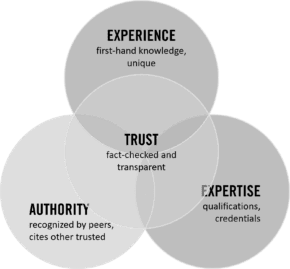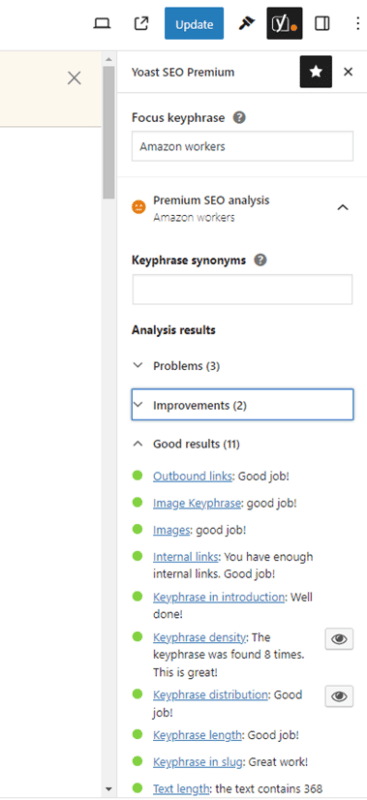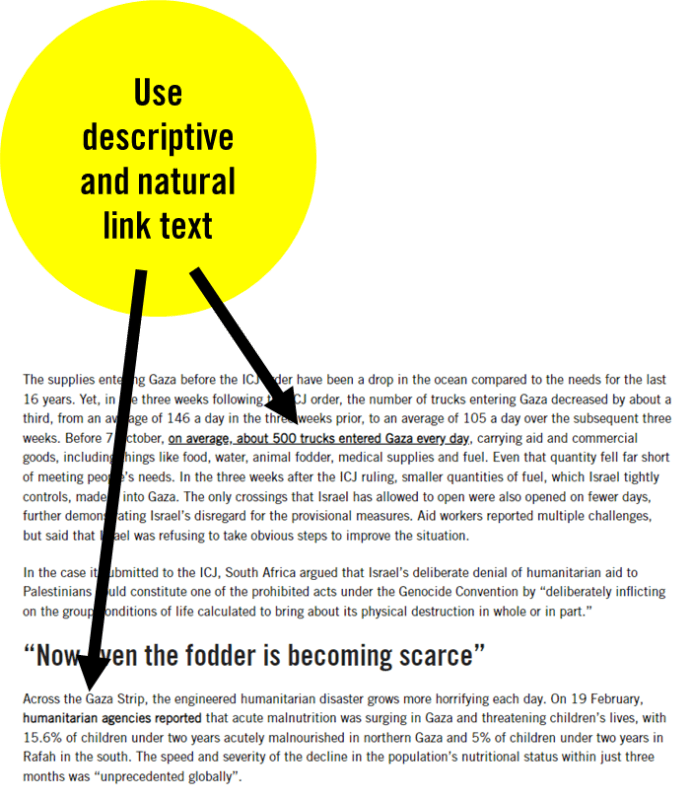What is Search Engine Optimisation?
Search Engine Optimization (SEO) is the practice of improving the quality and quantity of website traffic through non-paid (or organic) search engine results. The algorithms that determine what results show up when you put something into Google, Bing or other search engines are constantly changing. But ultimately, the main goal of search engines is to provide their users with trustworthy and relevant information that effectively answers the user’s questions.
So how do we improve Amnesty’s visibility on search engine results pages? We answer the questions that we know people are asking search engines.
While it can be easy to think of SEO as a box to check when creating content online, the most effective SEO happens when you consider your audiences’ intent and experience at the very beginning of the content creation process.

How do search engines work?
Before considering ways to optimise our content for organic traffic through search engines, we should start with some foundational knowledge about how search engines work. What is going on behind the scenes when we put a query into Google?
Crawling
Like human users, search engines ‘read’ and analyse web pages to determine what the page is about.
Like us, they know that certain parts of the page, like Page Titles or Headings, are a reliable way to quickly skim a page to figure out what it’s about. Search engines also collect information about web pages that most human users won’t see, like metadata or schematic markup.
Search engines do this using a programme called a crawler, which navigates the web using links between pages to discover new content. Crawlers will recrawl content to make sure their information is up to date. Crawl frequency varies a lot from page to page, but generally, high-traffic websites get recrawled more frequently than low-traffic websites.
Indexing
As a crawler crawls the web, it stores information in a database so it can be more easily referenced to generate search queries for users. That information is stored in a way that groups content together if it covers similar topics or topics that relate to each other.
There are separate databases for every country, which is why search engine results are different in different parts of the world.
Ranking
Search engines then use the information in those databases to determine what content best matches what the user is searching for. They will also factor in performance metrics like average engagement time or bounce rate to determine if users find the page useful.
The list of ranking factors that determine how results pages are generated is constantly evolving. Google and other search engines regularly release updates that impact how their algorithm interprets different factors, which is why you might see some fluctuation in your search visibility or organic traffic.
Search engines are also becoming increasingly personalised, which means they can be slightly different for people even if they are searching from the same location. Search engines will consider what websites you tend to view more



What factors do search engines prioritise?
Search engines are only as useful as the information they present to users. That is why it is why making useful, high quality content is the primary goal in any SEO strategy.
But what does ‘useful content’ mean? This is the question that Google and other search engines are trying to answer with continuous updates to their algorithm. And while it’s nearly impossible to monitor the constantly changing list of hundreds of factors, Google has provided content producers with a useful model called the EEAT model to explain the overall rationale behind their algorithm changes.
- Experience – First-hand knowledge, people sharing their unique stories. Original content that isn’t duplicated on other sites.
- Expertise – Published by a person or brand who has credentials and a background that is relevant to the topic they’re writing about.
- Authority – Cited by other websites, which indicates that the content is reliable.
- Trust – Combination of experience, expertise and authority. Information is fact-checked and transparent. The site is secure and unlikely to get hacked.

Search engine results page features
Search engine results pages (SERPs) can look different depending on what you are searching for. If you put in a search query like ‘recipe for avgolemono soup’, a carousel of recipes will show up with information like ingredients and how long it takes to follow each recipe. But if you put in ‘greece news’, the SERP looks really different and features news stories at the top.
This is because search engines like Google use different SERP features that make it easier for searchers to find what they are looking for faster. SERP features pull small pieces of content from your page, like text, images or videos, and use them to create rich media-filled results pages. The list of SERP features is constantly evolving but some common ones include;
If your content is optimised for SERP features, it will get more visibility on the SERP and bring in more organic traffic. Optimisation for each type of SERP feature is different. It’s wise to research which ones show up for the keywords you’re targeting before you start writing your content.


Keyword research for reactive
There are a lot of free SEO tools that we can recommend if you would like to do more keyword research when working on reactive stories.
- Google Trends – The Explore section in Google Trends is a great way to compare different topics or keywords over a long period of time. It also provides you with a list of related keywords, which can be great inspiration when deciding on subtopics you might want to include.
- Ahref free keyword generator – Will provide you with keyword lists that include keyword volume and competitiveness.
If you are writing an explainer with a question/answer format, you should definitely check out tools like AlsoAsked and Answer the Public, which provide a list of questions people ask via search. You can optimise for these searches by structuring the questions as headings on your page.
Keep in mind that a lot of free SEO tools only give you a limited number of searches every day, so use them sparingly!


How to optimise for search
Once you’ve done your keyword research and decided which search queries you want to target, there are a few things you can do within the content of your page to optimise for those keywords.
Certain parts of your page carry more weight than others when search engines interpret how relevant they are to different search queries. We don’t want to overuse our keywords since search engines now recognise that keyword stuffing reduces the quality of the page. But, it is possible to tactfully place your keywords in the right places so your page gets more visibility on the SERPs.
Headlines
It is important that your headlines fit the space for page titles on the SERPS. Aim for a title length of 70-80 characters.
Try to write headlines that begin with your main keywords. Note: This is why our house style for press releases is ‘country:title’ since it optimises your page for search terms that ask for news from that country.

Meta description
You can influence the way your link appears in the Search Engine Results Page, by editing your post’s metadata: the title and meta description.
Meta data optimization is about making your link clickable.
Go to the Yoast settings to add your meta description.

Schema Markup
Schema markup is a great way to provide context about your content that can be understood by search engines. This context makes it easier for them to render more relevant results pages.
There is a long list of objects that can be identified with schema markup, but the most relevant one for Amnesty content is the News Article markup.
You can easily apply News Article markup to your page by going into the Yoast settings and selecting News Article as your Page Type.
Main text
Content that does well in search engines tends to be the most readable and engaging content.
Readability principles apply:
- Shorter sentences
- Shorter paragraphs
- Accessible language
Yoast’s keyword analysis looks at keyword distribution: in the first 100 words of the text, in the subheadings, and distributed throughout the text.
Remember, the analysis is only as good as the keyword you’ve chosen.

Links
Internal linking is an essential factor for search engines.
If a post or page gets many links, this signals to Google that it’s an essential or high-value article. This counts for internal (links to other pages on amnesty.org) and external links (other websites).
You could add internal links in your post to:
- Relevant reports
- Previous news posts
- Relevant petitions
- Relevant evergreen pages
Add outbound links to good resources and info that users can’t find on our own website.

Backlinks
When your post is linked by other websites that shows Google you are a trustworthy source, especially if those links come from authoritative websites.
Be on the lookout for opportunities to gain strategic backlinks to your content. If you are working with external partners, provide them with links so it is easier for them to cite your work.
For example, provide links to your page when you send the material to journalists. If the media coverage you secure includes links your post on amnesty.org, it will have a positive effect on search visibility.

URL slug
The URL slug is the text part of the URL which is unique to your page. On most sites, the URL slug will use the page title by default. But if your page title is really long, then so will your URL.
Google’s guidelines say a good slug is concise, simple to understand and contains relevant keywords.
Our news post slugs are often quite long, as they are generated by the page title/headline.
To optimize your slug:
- Include your keyword or key phrase.
- Leave out ‘function words’ like “a”, “the” and “and”.
- Lowercase letters only.
- URL slugs should be permanent – don’t change after publishing.
- Not too short or vague. URL slugs can’t be duplicated – they each need to be specific to the page.

Images
Including images throughout your post can make it easier to engage with and increase the time users spend on the page. The metadata attached to the images on your page also provides confirmation to search engines that the page is relevant to your target keywords.
- Use your key phrase in the file name.
- Keep file size under 1MB (for a quick page load speed).
- Add a caption.
- Add alt text.

Evergreen Content
Evergreen content is search-optimized content that is continually relevant and stays “fresh” for readers over a long period of time. It continues to be relevant long past its publication date, with search traffic growing over time.
Here is a demonstration of how search traffic varies between regular News content and Evergreen content.
Evergreen content, for the most part, takes care of its own distribution and content marketing for you AND it naturally grows over time without too much extra work or promotion. Yes, it really is almost too good to be true.
When creating evergreen content, it’s important to remember some of the fundamental principles of SEO that I covered earlier in this guide. Are people already interested in this subject? If they are, what are they looking for? Suppose I am writing an evergreen page about abortion rights and my keyword research indicates that a lot of people are looking for a list of countries where different types of substances have been decriminalized. In that case, I will want to make sure that information is included on my evergreen page.
News
Evergreen
Adding Evergreen content to your Content strategy
When thinking about creating evergreen content, you should think about how your new content relates to other related content across your site. This is why it’s important to put together an evergreen content strategy that identifies the different kinds of evergreen content you plan on creating, setting up goals and targets for those different types of content and perhaps even developing editorial guidelines on how and when you should write new content.
The Tree Model
The Tree Model is a useful way to think about how to create an effective evergreen content strategy that addresses the three main criteria that search engines use when they list content in the search results pages (see above section on Relevancy, Authority and Usefulness).
Just like you can observe different parts of a tree to see how healthy it is, you can also look at different parts of content on a particular topic or issue to see whether or not search engines will find your content Relevant, Authoritative and Useful. The key to creating an effective content strategy is finding out how to balance your efforts across all four areas.
Pillar Content – The Trunk
- Long, clearly structured informative pieces.
- Should be optimized and updated over time, all while staying on the same URL
- Examples on amnesty.org can be found here.
Sub-categories or explainers – The Branches
- More in-depth information on particular topic or event.
- When focused on an particular event, for example a protest, you might want to update this page a few times while search interest is high
- When focused on a sub-topic that is covered by an existing Pillar content page, for example LGBTI rights (a sub-category of discrimination,) then you will want to update this over time just as you would do with Pillar Content
- Example of event specific explainer on amnesty.org can be found here.
- Example of a subcategory on amnesty.org can be found here.
News and trending – leaves
- Time-specific, reactive pages that help your site stay relevant but will eventually become outdated.
- You may want to update this page once or twice to provide updates on a specific story. For example, if you publish a news page about an upcoming trial, you might want to update that page later notifying users of the result of the trial.
- These pages will get a lot of traffic right after they are published and while the story is still relevant but that traffic will probably drop off pretty quickly. You can increase that initial spike in traffic by making sure that your pillar content on relevant topics has a good SEO ranking for popular search terms.
Technical SEO – roots
- Page load speed, security, mobile accessible, page metadata and SEO schema
To demonstrate what this could look like in practice, we’ll look at what kind of content we would want to create on the death penalty.
We’d start by making sure we have a strong piece of pillar content or the Trunk of your death penalty content tree that explains Amnesty’s work on the death penalty.
This page is probably going to end up being pretty long, which is ok! Lots of keyword research tools can give you advice on how long your content should be and in some cases, they advise that your main pillar content be up to 2500 words.
But don’t be mistaken! This does not mean that you should use jargon or specialized language. These pages should be written as though you are explaining the issue to someone who is learning about it for the first time. Paragraphs should be short and you should incorporate videos, photos and infographics to help you explain Amnesty’s position on the issue.
So let’s say we publish our Death Penalty Issue page and it starts doing really well! It is ranking in the top 10 for all of our target keywords and getting a lot of organic traffic! But after a few months, we start to see those numbers drop. This means that we’ll want to do a bit of keyword research to see why that’s happening and identify ways to get the page back on track.

Then we get to the Branches of our content tree, which can be sub-topics or explainer pieces that go into a little more depth than our main piece of pillar content. An example of this could be the annual death penalty facts and figures page that we publish every year along with the Death Penalty report.
This page usually does quite well on amnesty.org and doesn’t need too much updating, as long as the formatting is done properly (more on that in the SEO writing part of this guide!)
We can go into a lot more depth about facts and figures on this page than we would on the main Issue page. This means that we can really focus on ranking for specific keywords that are looking for specific figures and statistics, which we identified as a major trend when we conducted keyword research on the death penalty.
Eventually, this page will stop getting as much traffic as it did during its first year. But having it and creating new content that is similar to it will mean that search engines will see our site as an authority on the issue which means that all of our death penalty content will perform better overall.

This brings us to the leaves part of the content tree, which is the news and reactive part. On most Amnesty websites, this is where we generally produce most of our website content. To apply this to our death penalty content tree, we’ll want to look at a press release that is related to the death penalty. Here is a press release that we published about two people who were executed in Iran.
Now since we have built up good Authority on our website for keywords related to death penalty with the Trunk and Branch part of our content tree, we should expect our reactive content on the death penalty to go to the top of relevant search engine result pages pretty quickly.
Publishing this content in an efficient and timely manner also helps us maintain Relevancy on death penalty related search terms. Having a constant and steady flow of this kind of reactive content will have a positive knock-on effect for the rest of our death penalty content across the site. On amnesty.org, we have seen how a reduction in reactive content on specific topics has resulted in a decrease in organic traffic to the rest of the evergreen content that we’ve produced on that topic.
The last part of our content tree that deserves mention is the Technical SEO or the Roots. This is the part of the tree that you can’t really see but has a massive behind-the-scenes effect on how well your content will perform in terms of organic search. You can read more about Technical SEO here.
Technical SEO is about making sure that search engines can crawl your website, checking to see how long it takes for your pages to load, and improving mobile accessibility on your website. Doing this work well will have a positive impact on your site overall and is definitely something worth investing in if you want to increase organic traffic to your website!

How to create evergreen content
People will have different preferences on the specific tools and techniques that they use to create evergreen content, but hopefully this step by step guide will prove useful to those who are just getting started.
1) Gap Analysis – What should we write about?
As mentioned a few times in this guide, its important for all of your SEO content to be driven by what your audience wants to know rather than what you want your audience to know. Gap Analysis is a useful way to see what content your audience is looking for but can’t find on your website.
Our digital team at the IS uses a tool called SEMrush to conduct gap analysis to compare amnesty.org search rankings to our competitors. If we can see that our competitors have high ranking for a high volume keyword that we could create content for, then we add it to a list of potential Pillar content that could be added to our site.
Get in touch with the Digital Operations team at the IS if you would like some help running an initial Gap Analysis report on your site.

2) Keyword Research – What should we talk about on our page?
After a bit of Gap Analysis, you’ll have a list of topics that you can choose from to get started with your Pillar content.
You can make your keyword research as complex or basic as you’d like. We use SEMrush to find out what kind of questions people tend to ask when searching on a particular subject. We can also use it to look into the pages that are top ranked for our main keywords and figure out what other keywords they are ranking for.
If you don’t have access to one of these tools, you can search for your main keywords in incognito mode and check out what kind of topics are covered by the top-ranking pages for those search terms. Can we incorporate some of these topics into our page?
3) Content Briefs
It’s important to clearly articulate your goals and intentions when writing content briefs, but it’s especially important when writing briefs for SEO work.
What audience are you targeting? What evidence supports the argument that those audiences are already looking for this content? What kind of engagement do we want to have on the page? Do we want them to be sharing the page with their networks or is it more important that they spend a lot of time on the page?
The most important part of an SEO content brief is to list out the keywords that you are trying to rank for with your page. This is critical to the optimization work that you’ll be doing later on.
Remember these briefs should not only be designed for the first version of the page you are writing. SEO is a long term project and the insights in your content brief should instruct how often you should be updating your content.
4) SEO writing
One aspect of SEO that has changed a lot over the past decade is how to incorporate optimization into your writing. 10 years ago, you were rewarded for keyword stuffing or overusing the keywords that you were trying to rank for.
That is no longer the case!
The most important factor to consider in SEO writing is to make sure your content is easy to read. Keep your paragraphs short, 2-3 sentences maximum, avoid jargon and specialized language and use subheadings, images and videos to break up the text.
Subheadings are a massive part of SEO writing. If you know that you are targeting a particular keyword, you can assume that you’ll have a group of people visiting your page looking for that specific element of what you’re writing about. Make life easy for those people by using a subheading!
More on SEO writing here.
5) Keyword Tracking
Take all of those keywords that you identified during your keyword research and throw them into your favourite position tracking tool.
The team working on amnesty.org use SEMrush for keyword tracking. SEMrush not only gives you your rank for each keyword, but also tells you if you’ve made it into any of the featured snippets.
All of our keywords are tagged to a particular page so that we can track our progress on a page by page progress.
Once a month, we go in a monitor how our rankings have changed. If we notice that a page is losing ranking for a lot of major keywords, then we may want to investigate that a bit.

6) Optimization
If we identify a page that we would like to optimize using our position tracking tools, then we’ll want to ask ourselves a few questions.
What do the Top 10 pages for those keywords have that our page doesn’t? Can we add anything to improve our relevancy?
Are other websites linking to our page? Are people sharing our page on social media? What can we do to improve our authority on this topic?
Are we producing a lot of content on this topic elsewhere on our site? Should we try to cover more news on this subject to make our site more relevant?
Remember to take note of what changes you make to your page so that you can track and see if the changes have a positive or negative impact on your page!


